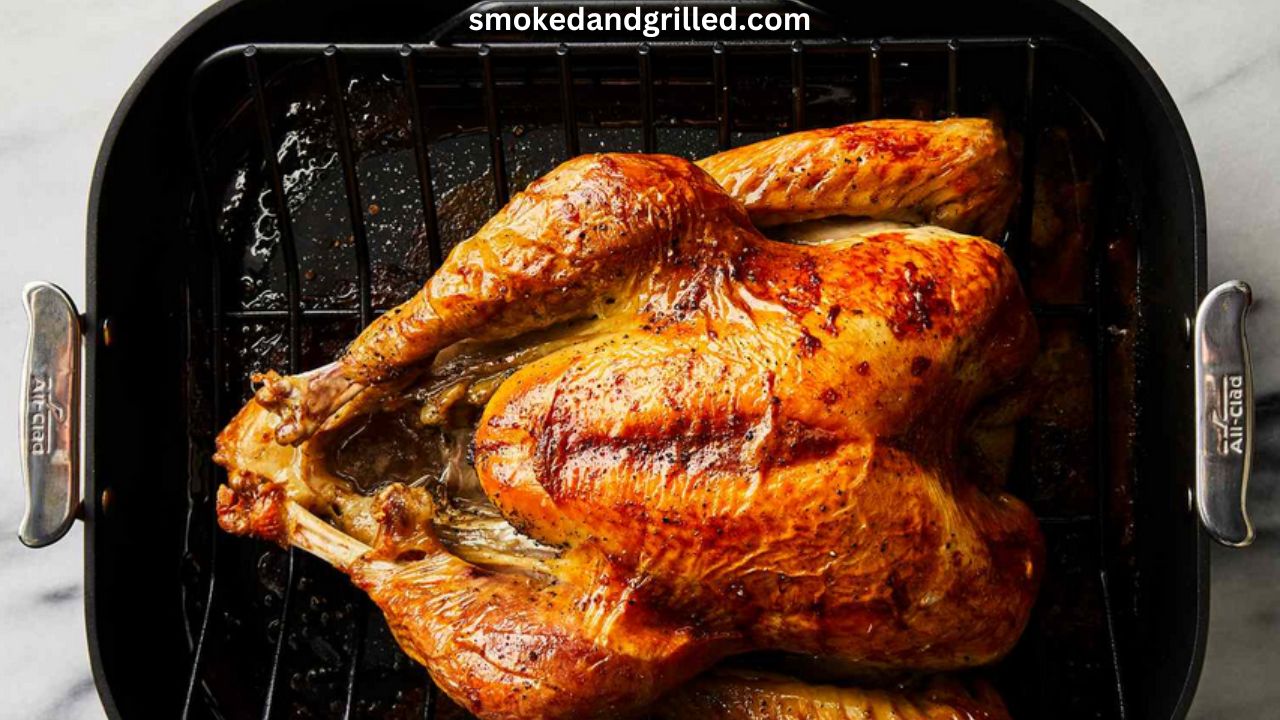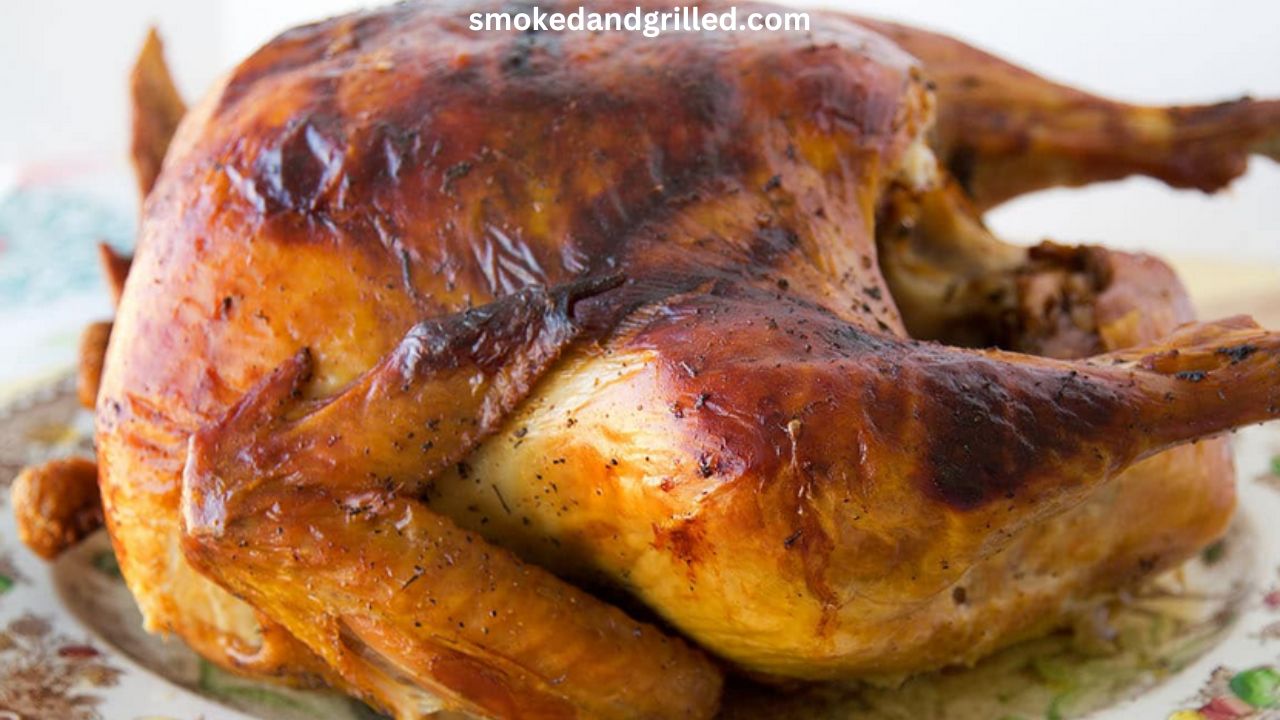The process of brining has been celebrated for generations as a game-changer for improving the taste and moisture of poultry.
This is especially true of the Thanksgiving turkey. Does the time spent brining make a difference, though?
Is it possible to brine a turkey for an entire day and a half? The response could shock you. A turkey can be brined for up to 48 hours with impressive effects.
The turkey is brined by being immersed in a saltwater solution that has been seasoned.
The longer the turkey spends in the brine, the more time it has to absorb the flavourings and become tender and flavorful.
But you should proceed with caution when it comes to the lengthy brining process.
If not watched closely, the salt level can rise too high, and the texture can change. To get the best results, you need to think about the turkey’s size and modify the brine salt accordingly.
Can You Brine A Turkey For 48 Hours?
The suggested time for brining a turkey is no more than 48 hours, or two days. Some recipes, however, call for brining for 24 to 72 hours.
Throughout the brining process, it’s crucial to maintain the turkey and brine in a refrigerator at 40°F or less. Over brining might make the bird too salty and give it a spongy texture.
Take the turkey out of the brine when the advised period has passed. You can soak the turkey in water to remove some of the salts after over brining.
By letting the turkey soak up a saltwater solution over night, wet brining produces a bird that is highly tasty and full of juices in the morning.
Never pour hot or warm brine over a raw turkey to prevent the growth of possible bacteria.
What Happens If You Brine A Turkey Longer Than 24 Hours?
There are a few consequences to think about if you brine a turkey for more than 24 hours.
Although the goal of brining is to improve the meat’s flavour and texture by locking in moisture, excessive brining can have the opposite effect.
The potential for the turkey to get too salty is a major worry when brining it for an extended period of time.
In addition, the turkey’s natural juices may be lost if it is brined for too long.
While brining might assist keep a bird moist at first, the process can backfire if the bird is left in the brine for too long.
These problems can be avoided by keeping a close eye on the brining time and adhering to the directions provided.
To get the required flavour and texture without compromising the quality of the turkey, a shorter brining period or a lower concentration of salt in the brine is recommended.
Should You Adjust The Amount Of Salt In The Recipe If You Brine A Turkey For 48 Hours?
For optimal results when brining a turkey for 48 hours, pay attention to the salt content of the recipe.
Because the turkey absorbs more salt from the brine during the lengthier brining time, the final product may be too salty if the salt concentration is not corrected.
When brining a turkey for 48 hours, it’s best to use a brine with less salt to prevent the meat from becoming overly salty.
However, a middle ground is required. Although cutting back on the salt content is recommended, you shouldn’t do away with it altogether because of the vital role it plays in the brining procedure.
The protein in the turkey is broken down, the moisture is locked in, and the flavour is infused.
If you want to know how much salt to add, it’s better to use a tried-and-true brine recipe made for a long brining time. This prevents an overly salty end result while yet providing the desired flavour.
What Temperature Should The Brine Be When You Start Brining The Turkey?
The temperature of the brine when you start brining the turkey is an important factor to consider for food safety.
It is recommended to begin the brining process with a chilled brine, ideally below 40°F (4°C). This helps maintain a safe temperature range and inhibits bacterial growth during the brining period.
Here is a table summarizing the recommended temperature range for the brine:
| Brine Temperature | Recommendation |
| Below 40°F (4°C) | Ideal and safest |
| 40°F to 45°F (4°C to 7°C) | Acceptable, but monitor closely |
| Above 45°F (7°C) | Not recommended due to increased risk of bacterial growth |
It’s important to note that as the turkey is submerged in the brine, the temperature will gradually rise.
To maintain a safe temperature, it is advisable to refrigerate the turkey and brine mixture throughout the brining process.
This ensures that the turkey remains at a safe temperature and reduces the risk of foodborne illnesses.
Can You Use A Pre-Made Brine Solution Or Should You Make Your Own?
It’s up to you if you want to use a ready-made brine solution or if you want to make your own. There are pros and cons to both choices.
By eliminating the need to source and measure out individual ingredients, using a pre-made brine solution is a time- and labor-saver.
You can find these pre-mixed brines in most grocery stores; they often include a combination of salt, sugar, and other ingredients.
You may get the results you want with minimal time spent on recipe formulation because of the uniformity and consistency of the flavour profile provided by these products.
Making your own brine, on the other hand, gives you more leeway in terms of seasoning.
Making your own brine also allows you to tailor the salt and other ingredient amounts to your tastes and nutritional needs.
The end outcome of either course of action might be scrumptious. A pre-made brine solution can be helpful if you’re looking for consistency and ease of use.
But if you like to play around with flavours and have complete control over the components, then making your own brine might be the way to go.
Are there any alternatives to brining for enhancing the flavor of turkey?
Certainly! Brining is a popular method for enhancing the flavor of turkey, but there are alternative techniques that can also elevate the taste of your bird. Consider these flavorful alternatives:
1- Infusing The Turkey With Rich Flavors:
The turkey can be infused with rich tastes and roasted with a delectable crust by applying a dry rub mixture of herbs, spices, salt, and sugar straight to the bird.
2- Flavor Enhancement With Herb Butter:
Combine herbs, garlic, and spices into melted butter to make compound butter. To enhance flavor and moisture while cooking, carefully remove the skin from the turkey and rub the herb butter all over the meat.
3- Injecting Exquisite Flavors:
A marinade or seasoned liquid can be injected directly into the turkey using a flavor injector, permeating the meat and imparting exquisite flavors.
4- Delicious Combination:
Stuff the bird with a delicious combination. The stuffing adds flavor to the turkey while it roasts, making for a delicious meal.
5- Aromatics for Irresistible Aromas:
Before roasting the turkey, stuff the cavity with aromatics such onions, garlic, herbs, lemon slices, and cinnamon sticks. The aromatics and alluring aromas of these components permeate the meat.
These alternatives offer creative ways to enhance the taste of your turkey and can be tailored to your preferences. Experimenting with different techniques will allow you to discover your preferred method of flavor enhancement.
Can You Brine A Turkey If It’s Already Been Seasoned With A Dry Rub?
It is feasible to brine a turkey that has already been rubbed with dry seasoning, but doing so requires special attention.
The primary goal of brining is to improve the turkey’s flavour and moisture content through absorption of the brine solution.
However, the turkey may not need additional seasoning if a dry rub was already applied.
Brine can also add extra moisture while roasting, which might compromise the skin’s texture and crispness.
Brine a turkey that has already been seasoned, but make sure to adapt the brine recipe properly.
To avoid over-seasoning, cut back on the salt in the brine, and if you’re worried about textural changes, try brining for less time.
To minimise unpleasant taste combinations, a milder or complementing brine flavour profile should be used.
The final decision should be based on a thorough evaluation of the turkey’s current seasoning and your preferences for flavour and presentation.
Are There Any Specific Safety Precautions To Follow When Brining A Turkey For An Extended Period?
When brining a turkey for an extended period, it’s important to follow specific safety precautions to ensure the health and well-being of everyone who will be consuming the bird. Here are some essential safety guidelines:
1- Chilling The Turkey And Brine To Inhibit Microorganism Growth
The turkey and brine should be chilled the entire time they are brining. This inhibits the multiplication of disease-causing microorganisms. Keep the fridge at or below 40 degrees Fahrenheit (4 degrees Celsius).
2- Proper Storage Of Turkey And Brine
You can store the turkey and brine in resealable plastic bags or food-safe containers. Make sure the turkey can fit comfortably inside the container and that the lid is secure to avoid any leakage or cross-contamination.
3- Thoroughly Washing Hands Before Handling Turkey Or Making Brine
Make sure you wash your hands thoroughly before handling the turkey or making the brine. To prevent the transmission of bacteria, wash your hands well with soap and warm water before and after handling the raw turkey.
4- Cooking The Brined Turkey To The Appropriate Internal Temperature
After the turkey has been brined, it needs to be cooked to an appropriate internal temperature. The inside temperature of the bird must reach 165 degrees Fahrenheit (74 degrees Celsius) in order to destroy any bacteria.
By following these safety precautions, you can enjoy a delicious and safe brined turkey without compromising anyone’s health.
Can You Brine A Turkey If You Plan To Deep Fry It?
Yes, you can brine a turkey even if you plan to deep fry it. In fact, brining can enhance the flavor and moisture of a deep-fried turkey, resulting in a delicious and juicy end result.
However, there are a few important considerations to keep in mind:
Adjust the brining time when preparing a turkey for deep frying.
Since the turkey will undergo a shorter cooking time compared to roasting, a shorter brining period is recommended to avoid the risk of the meat becoming overly salty.
Be cautious of the interaction between the brine and the frying oil. The salt in the brine can affect the oil temperature and cause it to splatter.
Ensure that the turkey is adequately dried and allow it to come to room temperature before frying.
By taking these precautions, brining can contribute to a flavorful and moist deep-fried turkey.
What Are The Benefits Of Brining A Turkey?
1- The turkey will be more juicy and flavorful after being brined.
2- The turkey’s flavor is improved because to the infusion of herbs and spices into the meat by the saltwater solution.
3- By brining the meat, you can be sure that the seasoning will get all the way through to the inside.
4- Proteins are dissolved by the salt in the brine, making the meat soft and juicy.
5- If you’re using a leaner cut of turkey, brining it will help prevent it from drying out during cooking.
6- By altering the brine with herbs, spices, citrus, or other aromatic elements, you can create a wide variety of new flavor profiles.
7- It is possible to achieve a well-balanced seasoning without masking the turkey’s natural flavors by adjusting the salt content in the brine.
8- The brine helps the turkey retain its moisture and tenderness during cooking, making it easier to get a perfect result.
9- The golden color and crisp texture of the skin of a turkey that has been brined add to the dish’s visual appeal.
Are There Any Risks Or Drawbacks To Brining A Turkey For An Extended Period?
While brining a turkey can yield fantastic results, there are a few risks and drawbacks to be aware of when brining for an extended period.
1- The turkey will absorb more salt the longer it remains in the brine. This may lead to a salty aftertaste that you don’t want to experience.
2- Brining the turkey for too long might make it too soft, if not mushy. This can cause the meat to lose its desirable texture in the mouth.
3- The turkey’s natural juices may be extracted over prolonged brining, leading to a drier final product even though the process of brining initially helps retain moisture.
4- A prolonged brining period can mask the turkey’s natural flavors, depending on the brine formulation. The brine’s seasoning and the turkey’s natural flavor should complement each other.
Five- If the brining temperature isn’t kept steady, bacteria can multiply throughout a longer brining period. To prevent food poisoning, keep the brined turkey in the fridge.
FAQs
How Should You Store The Brined Turkey Before Cooking?
It’s crucial to ensure food safety by storing the brined turkey in the right way before cooking.
The turkey should be rinsed to remove any excess brine, patted dry, and then placed on a tray or in a roasting pan.
Wrap the turkey in plastic wrap or foil as loosely as possible and store it in the fridge until you’re ready to cook it.
The turkey must be refrigerated at a temperature of less than 40 degrees Fahrenheit (4 degrees Celsius) to stop the growth of harmful bacteria.
The risk of food poisoning increases if the turkey is left out at room temperature for a long time.
If your brine recipe includes precise storage requirements, be sure to adhere to those. If not, seek a trusted resource for guidance.
Can You Reuse The Brine For Multiple Turkeys?
Concerns over food safety make it wise to avoid reusing brine for many turkeys.
After being utilised, brines may harbour harmful bacteria from raw turkey. The flavour of future turkeys may have been affected because the brine absorbed flavours from the prior turkey.
To avoid contamination and keep the brine’s flavour consistent, it’s preferable to make a new batch for each turkey.
Can You Brine A Turkey If You’re Planning To Smoke It?
Absolutely! The flavour and texture of a smoked turkey can be greatly improved through the process of brining.
The meat is tenderised and given extra moisture by the brine, and its flavour is also enhanced. Remove any remaining brine from the turkey, pat it dry, and bring it to room temperature before smoking.
Better smoke absorption is the result. A brined and smoked turkey will turn out excellent and flavorful if you follow your standard smoking recipe and method.
For a successful and pleasurable smoking session, just make sure you have the right gear and employ safe smoking procedures.
What Are Some Flavor Variations Or Additions You Can Incorporate Into A Turkey Brine?
The flavour of a turkey can be altered by adding different spices and seasonings to the brine.
Adding aromatic herbs like rosemary, thyme, or sage is a common choice.
To add a touch of spice and heat, you can also use things like peppercorns, cloves, and cinnamon sticks. Zest or slices of citrus fruit, such as oranges or lemons, can impart a bright, refreshing flavour.
Brown sugar, maple syrup, or honey would give it a unique sweet and savoury flavour.
Garlic, onions, bay leaves, or even apple cider or wine could be used instead to give depth. Don’t be scared to try new things until you find the perfect flavour combination for you.
Does Brining Work For All Types Of Poultry Or Just Turkey?
In addition to turkey, brining works well with other varieties of fowl. Brined poultry includes chicken, duck, Cornish hens, and game birds.
All of these different kinds of poultry benefit from the brining process because it increases moisture, tenderness, and flavour.
However, the type of fowl being brined may affect the brining period and flavour profile.
To get the greatest results from brining a bird, it’s important to tailor the brining recipe and time frame to the bird’s specific size, weight, and other qualities.
Conclusion
In conclusion, if you take the right precautions, a turkey brined for 48 hours can produce delicious and juicy results.
Risks, such as increased saltiness or changes in texture, associated with prolonged brining times can be reduced by modifying the brine mix and keeping a constant eye on the process.
To prevent any contamination, keep the turkey and brine in the fridge during the whole brining process.
The turkey’s moisture, softness, and flavour can all be improved with a brine, but it’s vital to find the right balance and adjust the brining process accordingly.
The goal is to create a memorable turkey dinner that pleases your taste buds and your visitors, regardless of whether you brine the bird, try out new flavouring methods, or try out new cooking procedures.



